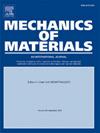The effect of microstructural inertia on plastic localization and void growth in porous solids
IF 4.1
3区 材料科学
Q2 MATERIALS SCIENCE, MULTIDISCIPLINARY
引用次数: 0
Abstract
This paper investigates the impact of microinertia on plastic localization, void growth, and coalescence in ductile porous materials subjected to high strain rates. For that purpose, we have performed finite element calculations on a flat double-notched specimen subjected to dynamic plane strain tension. The simulations employ three distinct approaches to model the mechanical behavior of the porous aggregate: (1) discrete voids within a matrix material governed by von Mises plasticity; (2) homogenized porosity represented using standard quasi-static Gurson–Tvergaard plasticity; and (3) homogenized porosity described with Gurson–Tvergaard plasticity extended by Molinari and Mercier (2001) to account for microinertia effects. The porous microstructures used in the simulations are representative of additive manufactured metals, featuring initial void volume fractions varying between 0.5% and 4%, and pore diameters ranging from to (Marvi-Mashhadi et al., 2021, Nieto-Fuentes et al., 2023). The applied tensile velocities ranged from to , producing strain rates between and , and stress triaxiality values spanning from 4 to 30. The simulations with discrete voids validate the calculations performed using homogenized porosity and microinertia effects, demonstrating that higher strain rates and larger pore sizes lead to slower void growth and a delayed, regularized plastic localization. Conversely, the standard Gurson–Tvergaard model shows notable mesh sensitivity and fails to describe the influence of the loading rate on plastic localization. Ultimately, the comparison between finite element models with discrete voids and those with homogenized porosity illustrates the stabilizing effects of porous microstructure and multiscale inertia on dynamic plastic flow, while also highlighting the strengths of the constitutive model introduced by Molinari and Mercier (2001) for simulating engineering problems involving porous ductile materials subjected to high-velocity impacts.
微观结构惯性对多孔固体塑性局部化和孔洞生长的影响
本文研究了微惯性对承受高应变速率的韧性多孔材料中塑性局部化、空隙增长和凝聚的影响。为此,我们对承受动态平面应变拉伸的平面双缺口试样进行了有限元计算。模拟采用了三种不同的方法来模拟多孔集合体的机械行为:(1) 由 von Mises 塑性支配的基体材料中的离散空隙;(2) 使用标准准静态 Gurson-Tvergaard 塑性表示的均质多孔性;(3) 由 Molinari 和 Mercier(2001 年)扩展的 Gurson-Tvergaard 塑性描述的均质多孔性,以考虑微惯性效应。模拟中使用的多孔微结构是添加剂制造金属的代表,其初始空隙体积分数在 0.5% 到 4% 之间,孔隙直径在 30μm 到 150μm 之间(Marvi-Mashhadi 等人,2021 年;Nieto-Fuentes 等人,2023 年)。施加的拉伸速度从 100 米/秒到 1000 米/秒不等,产生的应变率在 105s-1 到 106s-1 之间,应力三轴度值从 4 到 30 不等。利用离散空隙进行的模拟验证了利用均质化孔隙率和微惯性效应进行的计算,表明较高的应变速率和较大的孔隙尺寸会导致较慢的空隙增长和延迟的规则化塑性定位。相反,标准的 Gurson-Tvergaard 模型显示出明显的网格敏感性,无法描述加载速率对塑性局部化的影响。最后,离散空隙有限元模型与均匀化孔隙率有限元模型之间的比较说明了多孔微结构和多尺度惯性对动态塑性流动的稳定作用,同时也突出了 Molinari 和 Mercier(2001 年)引入的构成模型在模拟多孔韧性材料受高速冲击的工程问题方面的优势。
本文章由计算机程序翻译,如有差异,请以英文原文为准。
求助全文
约1分钟内获得全文
求助全文
来源期刊

Mechanics of Materials
工程技术-材料科学:综合
CiteScore
7.60
自引率
5.10%
发文量
243
审稿时长
46 days
期刊介绍:
Mechanics of Materials is a forum for original scientific research on the flow, fracture, and general constitutive behavior of geophysical, geotechnical and technological materials, with balanced coverage of advanced technological and natural materials, with balanced coverage of theoretical, experimental, and field investigations. Of special concern are macroscopic predictions based on microscopic models, identification of microscopic structures from limited overall macroscopic data, experimental and field results that lead to fundamental understanding of the behavior of materials, and coordinated experimental and analytical investigations that culminate in theories with predictive quality.
 求助内容:
求助内容: 应助结果提醒方式:
应助结果提醒方式:


